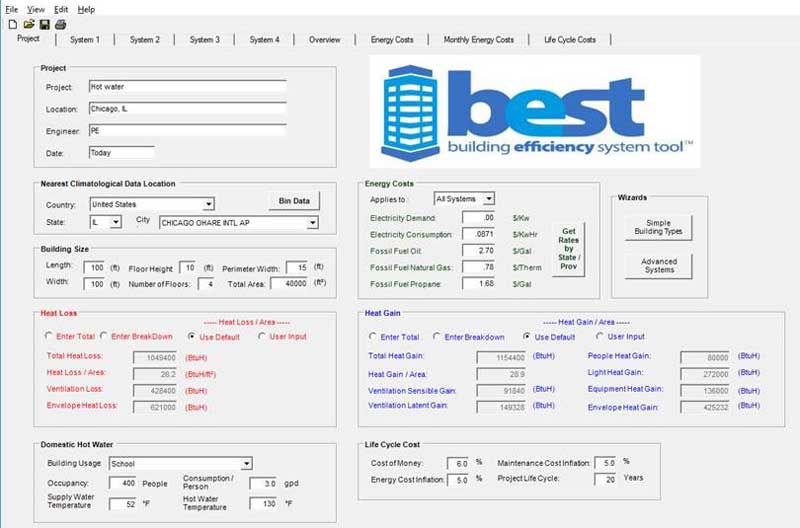Building on the foundation of a great tool and with more than two years of additional input from engineers, contractors and building owners, the Hydronic Industry Alliance-Commercial (HIA-C), a committee of the Radiant Professionals Alliance (RPA), has upgraded its interactive commercial building HVAC system efficiency comparison application, the Building Efficiency System Tool™ (BEST).
The revised software, which continues to be available online at no charge, considers Net Energy and energy sharing to flatten the energy demand curve year-round with hydronic solutions. To download BEST 5.0 HERE.
Upon its introduction, BEST solved a long-standing industry issue of being able to accurately compare different styles of HVAC systems, which are all tested to different standards, with various efficiency ratings (EER, IEER, SEER, COP, HSPF), as they are applied in an actual building. BEST 5.0 easily allows designers to comply with ASHRAE 209 Early Box Modeling requirements with the inclusion of real cost, budget, and comparative energy efficiency predictions. This results in understandable, better decision-making information for prospective builders, consulting engineers, and design-build professionals about their selection options for HVAC systems in the early design process.
BEST 5.0 now incorporates the savings consumption and energy costs of domestic water heating systems. Other new benefits include per-square-foot energy load based on your building’s usage and profile, and cost of local utilities with forecasted increasing energy costs. The new software is even easier to use yet still has the capabilities to be customized for each energy source (water, air or refrigerant), efficiency and labor.

The underlying algorithms use the Building Energy Efficiency Ratio (BEER), which takes certified AHRI data, manufacturers’ published performance data at multiple performance points, as-applied correction factors, performance curves for components, and pipe and duct required in a typical system, and combines them to bridge the gap between certified equipment efficiencies and real-world, entire building system efficiencies.
“BEST is unique in that it accounts for the performance of HVAC systems in the real world, and not just laboratory test conditions,” said Mark Chaffee of Taco Comfort Systems. “It uses this information to compare systems at the early stages of a project with limited information. Most of the legacy energy modeling software requires detailed input on the building construction and systems to arrive at any output. BEST does this quickly and easily.”
For example, most direct-expansion equipment is laboratory tested at fixed points that include an 80°F room air temperature and 50 percent humidity (80 DB/67 WB). While a designer needs to know the rated performance to calculate system efficiency, BEST goes further by using the performance at actual operating temperatures (73 DB/61 WB) to develop an overall system efficiency, thereby more closely mirroring actual building operation.
Simply enter the square footage of the building, the number of stories, and the nearest city for local weather data, and then chose up to four types of HVAC systems to compare — from more than 30 pre-loaded systems. The BEST features more than 100 default input settings, including system cost per square foot (provided by more than 50 contractors around the United States), each of which are adjustable to model any building in any location. BEST quickly outputs estimated installation cost, replacement cost, maintenance cost, monthly energy cost, electrical and fossil fuel consumption costs, total life cycle cost, cumulative life cycle cost by year, system payback time (as compared with other modeled systems), pump and fan HP, system integrated energy efficiency ratio (IEER), coefficient of performance (COP), and more.
“BEST is about what is known,” Chafee said. “It is a template where design and cost meet. Calculate the net energy in your building — BEST gives you the ability to look at the potential — before you spend big money or can’t change the installed product. BEST is about choices, not getting locked into a building comfort system that overpromises and underdelivers.”
Coming soon: DEER – a simulated Demand Day Energy Efficiency Report per the whole system.
To download the Building Efficiency System Tool™ for free, learn more about the Hydronic Industry Alliance-Commercial and the Radiant Professionals Alliance, or to join this important efficiency advocacy effort, visit www.HIA-C.org and www.radiantpros.org.
Since 1994, the Radiant Professionals Alliance, formerly the Radiant Panel Association, has been promoting radiant heating as comfortable, efficient, and healthy on behalf of its network of dedicated members, who share the desire to advance the understanding and acceptance of radiant and hydronic technology.

IAPMO
IAPMO develops and publishes the Uniform Plumbing Code®,the most widely recognized code of practice used by the plumbing industry worldwide; Uniform Mechanical Code®; Uniform Swimming Pool, Spa and Hot Tub Code®; and Uniform Solar Energy, Hydronics and Geothermal Code™ — the only plumbing, mechanical, solar energy and swimming pool codes designated by ANSI as American National Standards — and the Water Efficiency Standard (WE-Stand)™. IAPMO works with government, contractors, labor force, and manufacturers to produce product standards, technical manuals, personnel certification/educational programs and additional resources in order to meet the ever-evolving demands of the industry in protecting public health and safety.
Last modified: December 30, 2022

